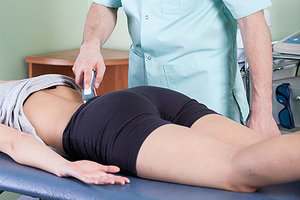We speak to many chiropractors during lectures and at trade shows, and often ask them, "Do you have a laser?" Many respond, "Yes," but when we query further about what type of laser they have, we draw a blank stare or a response of, "I don't know." Any chiropractor who does not know much about their laser could use a little bit of help with documentation.
The first step is to know the manufacturer of your laser, model, wavelength, maximum power output in watts or milliwatts, and the square area of your aperture.
1. Document Laser Penetration
Diode lasers use complex semiconductors. Depending on the wavelength, the laser will penetrate different depths into the body. The manufacturer should inform you about these figures. If the laser also utilizes LEDs, these will barely penetrate the body. Knowing what your target structure is and documenting the expected penetration is important.
Here are some expected penetration depths depending on the wavelength of your laser device according to The New Laser Therapy Handbook by Tuner and Hode (2010; pg 118):*
- 630-700 nm: 0.5-1 cm
- 700-800 nm: 2-3 cm
- 800-960 nm: 3-5 cm*
- 970-990 nm: 1-2 cm
- 990-1,200 nm: 4-5 cm
*800-890 nm: up to 4 cm; 900-910 nm: up to 5 cm; but drops to 3 cm at 930-960 nm.
2. Document the Technique
Your depth of penetration as documented in item #1 above can change depending on your treatment method, ranging from shallow to medium to deep. The choice of shallow, medium or deep pressure depends on the condition(s) being treated.
 Holding the laser off the skin will reduce the depth of laser penetration. This approach works well for dermatological conditions such as psoriasis or road rash. Medium-pressure treatment with the laser head on the skin is the general approach to laser therapy and will reach deeper-seated pathologies.
Holding the laser off the skin will reduce the depth of laser penetration. This approach works well for dermatological conditions such as psoriasis or road rash. Medium-pressure treatment with the laser head on the skin is the general approach to laser therapy and will reach deeper-seated pathologies.
To maximize penetration to areas such as facets and discs, the deep approach is preferable. By pushing the laser into the skin, it pressures the capillary blood out of the way, allowing even deeper penetration compared to the medium or shallow approach.
Key Documentation Items:
- Shallow (no pressure)
- Medium pressure
- Deep pressure
3. Document Effective Dosage
Dosage is expressed in Joules/cm², but documenting the amount of Joules delivered at the surface and describing the area being lased should be enough for proper documentation.
The key to effective treatment is the dosage at the target area. For example, if the dosage should be 5 J/cm² at the target, you may need 3-4 times more energy density or dose at the skin in order to allow the sufficient energy to travel through the skin, blood and tissues before it reaches the target.
Your documentation should note dosage at the skin and the approximate target area. There is approximately 50 percent loss of laser energy each centimeter into the tissue as the laser reaches the target, thus requiring higher dosage delivered at the surface.
Key Documentation Items:
- Dosage at skin surface
- Approximate dosage at target tissue
- Duration performed (necessary because HCPCS S8948 is a timed constant attendance modality)
Editor's Note: Part 2 of this article (April issue) will discuss 4) Documenting key physiology treatment goals; 5) Documenting health / safety precautions; and 6) Documenting results of treatment.
Dr. Michael Mathesie is a 1988 graduate of Life University. He has been practicing in Coral Springs, Fla., for 26 years, and teaching and utilizing laser therapy in his practice since 2005. Dr. Mathesie is a recipient of the Sports Chiropractor of the Year award, and two governors have appointed him to the Florida Board of Athletic Training and the Florida Board of Chiropractic Medicine.
Rob Berman is a partner at Berman Partners, LLC, a medical device sales, service and marketing company. He has held a variety of marketing roles during his career. Rob can be contacted by phone at 860-707-4220 or by email at
. His company website for new lasers is www.bermanpartners.com and for used lasers www.usedlasercenter.com.




